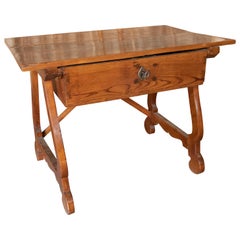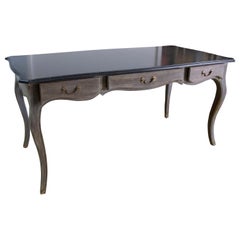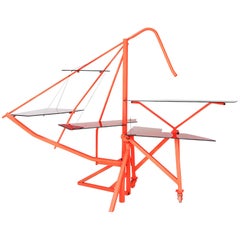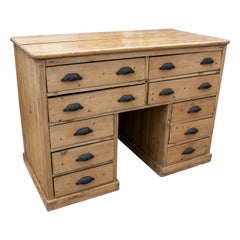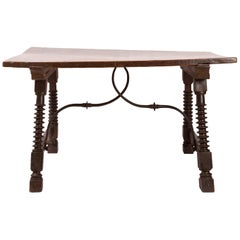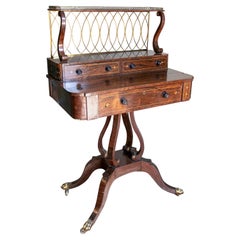Spain - Desks and Writing Tables
to
85
Height
to
Width
to
Depth
to
3,519
3,388
100
87
3
98
10
7
5
4
4
3
1
1
1
1
1
13
22
65
90
6
43
14
6
3
9
10
3
2
1
160
78
21
21
18
180
67
39
31
23
190
108
112
53
29
11
8
6
Item Ships From: Spain
17th Century Spanish Writing Desk with Drawer and Original Iron Lock
Located in Marbella, ES
17th Century Spanish writing desk with drawer and original iron lock.
Category
18th Century Spanish Antique Spain - Desks and Writing Tables
Materials
Wood
Iron Garden Table Base with Grapes Decoration and Corner Plants
Located in Marbella, ES
Iron Garden Table Base with Grapes Decoration and Corner Plants
Category
Late 20th Century French Spain - Desks and Writing Tables
Materials
Wood
Contemporary Orange Desk/Book Shelf by Guillermo Santomá Contemporary Design
By Guillermo Santomà
Located in Barcelona, ES
Desk or bookshelf
Manufactured by Guillermo Santomá
Edition Side Gallery
Barcelona, 2018
Aluminium, spray painting, wheels, methacrylate.
Category
2010s Spanish Spain - Desks and Writing Tables
Materials
Aluminum
Spanish Wooden Desk with Ten Drawers and Iron Pulls
Located in Marbella, ES
Spanish wooden desk with ten drawers and iron pulls.
Category
Early 20th Century Spanish Spain - Desks and Writing Tables
Materials
Iron
18th Century Spanish Trestle Style Writing Table, Turned Legs, Wrought Iron
Located in Madrid, ES
The tabletop of this 18th century Spanish table is one single wide plank, which over the years has warped slightly, adding an attractive twist to the surface and creating a piece of furniture with unique character. The deeply-coved spool turned leg...
Category
18th Century Spanish Rustic Antique Spain - Desks and Writing Tables
Materials
Wrought Iron
$7,293 Sale Price
35% Off
19th Century English Writing Table with Drawers and Bronze Fittings
Located in Marbella, ES
19th century English writing table with drawers and bronze fittings.
Category
Late 20th Century English Spain - Desks and Writing Tables
Materials
Bronze
Franco Albini Mahogany mid-centry Italian Table Model TL-22 produced by Poggi
By Franco Albini
Located in Barcelona, ES
Franco Albini & Franca Helg.
Dining table model no. TL22.
Manufactured by Poggi,
Italy, 1958.
Mahogany.
Measurements:
180.3 cm x 104.1 cm x 73 H cm.
70.98 in x 40.98 in x 28.74 in.
Literature:
Giuliana Gramigna, Repertorio 1950/1980, Milan, 1985, p. 123.
Franco Albini, was born in 1905 and died in 1977. He spent his childhood and part of his youth in Robbiate in Brianza, where he was born. Albini, as an adolescent moved with his family to Milan. Here he enrolled in the Faculty of Architecture of the Polytechnic and graduated in 1929. He started his professional activity in the studio of Gio Ponti and Emilio Lancia, with whom he collaborated for three years. At the 1929 International Exhibition in Barcelona (where Gio Ponti curated the Italian pavilion and Mies van der Rohe realized that of Germany) and in Paris where, as Franca Helg recounted, he had the opportunity to visit the studio by Le Corbusier.
In those three years, the works he carried out are admittedly of the twentieth century imprint. It is the meeting with Edoardo Persico that marked a clear turning point towards rationalism and the approach to the group of editors of "Casabella". The partly ironic and partly very harsh comments of the Neapolitan critic to a series of drawings, made by Albini for the design of some office furniture, caused him a great disturbance. “I spent days of real anguish - Albini recalls - I had to answer all the questions. I also had a fever, a large and long fever. "
The meted provoked Albini to openen a professional studio in via Panizza with Renato Camus and Giancarlo Palanti. The group of architects began to deal with public housing by participating in the competition for the Baracca district in San Siro in 1932 and then building the IFACP neighborhoods: Fabio Filzi (1936/38), Gabriele D'Annunzio and Ettore Ponti (1939).
During this period, Albini also worked on his first villa (Pestarini), which Giuseppe Pagano, architect and critic of the time, presented as follows: “This coherence, which the superficial rhetoric of fashionable jugglers calls intransigence, and which is instead the basis of understood between the fantasy of art and the reality of the craft, in Franco Albini, it is so rooted that it transforms theory into a moral attitude ".
But it is above all in the context of the exhibitions that the Milanese master experienced his compromise between that "rigor and poetic fantasy" of which Pagano speaks, coining the elements that became a recurring theme in his . The opening in 1933 of the new Triennale headquarters in Milan, in the Palazzo dell'Arte, was an important opportunity to express the strong innovative character of rationalist thinking, a gym in which to freely experiment with new materials and new solutions, but above all a "method". "Cultivated as a communication laboratory, the art of setting up was for the rationalists of the first generation what the perspective had been for the architects of humanism: the field open to a hypothesis of space that needed profound reflections before landing the concreteness of the construction site ".
Together with Giancarlo Palanti, Albini on the occasion of the V Triennale di Milano set up the steel structure house (with R. Camus, G. Mazzoleni, G. Minoletti and with the coordination of G. Pagano), for which he also designed the 'furniture. At the following Triennale of 1936, Persico dided, together with a group of young designers gathered by Pagano in the previous edition of 1933, Franco Albini took care of the preparations of the home exhibition. The setting up of Stanza per un uomo, at that same Triennale, allows us to understand the acute and ironic approach of Albini, as a man and as a designer: "Celebrating the beauty of mechanics was the imperative to which, for example, the surprising displays by Franco Albini who managed, in the subtle way of a refined and rarefied style, to sublimate their practical content in the metaphysics of daring still lifes: flying objects which marked in the void refined frames and metal intricacies the nodes of a fantastic cartography where industry finally became art free from purpose ".
That same year Albini and Romano designed the exhibition of the Ancient Italian Goldsmithery: vertical uprights, simple linear rods, designed the space. A theme, of the "flagpole", seemed to be the center of the evolution of production and the creative process. The concept is reworked over time, with the technique of decomposition and recomposition typical of Albinian design: in the preparation of the Scipione Exhibition and contemporary drawings (1941) the tapered flagpoles, on which the paintings and display cases were hung, are supported by a grid of steel cables; in the Vanzetti stand (1942) they take the V-shape; in the Olivetti shop in Paris (1956) the polished mahogany uprights support the shelves for the display of typewriters and calculators.
The flagpole is found, however, also in other areas. In the apartments he designed, it is used as a pivot on which the paintings can be suspended and rotated to allow different points of view, but at the same time as an element capable of dividing the spaces. The Veliero bookcase...
Category
Mid-20th Century Italian Mid-Century Modern Spain - Desks and Writing Tables
Materials
Mahogany
Very Fine Gilt Bronze Mounted Tulipwood and Amaranth Desk by L. Cueunieres
Located in Madrid, ES
A very fine gilt bronze mounted tulipwood and amaranth desk.
by L. Cueunières (active from 1870).
A french ormolu-mounted mahogany bureau plat.
By l. Cueunieres, third quarter 19t...
Category
1880s Antique Spain - Desks and Writing Tables
Materials
Fruitwood
French Regency Style Desk, Signed by the French Cabinetmarker G. Durand
Located in Saint-Ouen, FR
French Regency style desk. Signed by the French cabinetmarker G. Durand 19th century.
Desktop support in the front with two side drawers and original key.
Category
19th Century French Antique Spain - Desks and Writing Tables
Materials
Wood
"Buerau Plat" Desk by Linke
Located in Madrid, ES
"Buerau Plat" desk by Linke
"Bureau Plat" desk by linke elegant 19th century desk in light and stained wood. line of sinuous curves.measures:120x66x75cm.
Category
1890s Antique Spain - Desks and Writing Tables
Materials
Fruitwood
$10,103
Read More
This 19th-Century Gilded Desk Displays a Fanciful Kingdom in Marquetry
The stately piece brings both gravitas and whimsy to any work space.
Ask an Interior Designer: Work-from-Home Edition
Leaping into a design project, whether it's refreshing the bedroom or redoing the whole house, can be overwhelming. Luckily, we know more than a few interior designers. You asked questions on Instagram, and now they're answering.
18 Home Offices for Workaholic Design-Lovers
Proof that working from home is a perk.
Recently Viewed
View AllMore Ways To Browse
Sligh Lowry Desk
Used Classroom Desk
Vellum Desk
Vintage 1930 Writing Bureau
Whitewashed Desk
Zebrawood Desk
Antique Elizabethan Desk
Bamboo Campaign Desk
Bean Shaped Desk
Berkey And Gay Desk
Brass Sawhorse
Bureau A Gradin
Compass Drafting
Danilo Silvestrin
Danish Control Desk
Dansk Table 1970
Empire Partners Desk
Fabio Lenci Desk
